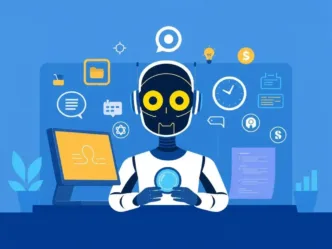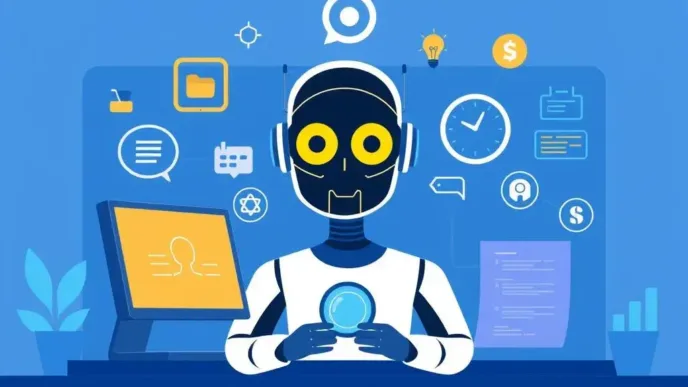Explore the future of conversational AI assistant in 2025. This comprehensive analysis covers their definitions, operational mechanisms, types, applications, benefits, challenges, and emerging trends, highlighting their transformative impact across industries. Enhance your understanding of how these advanced technologies are reshaping human-machine interactions for personal and enterprise use.
Conversational AI Assistant: A Comprehensive Analysis for 2025
Conversational AI assistants represent a transformative advancement in artificial intelligence, enabling seamless, human-like interactions through text or voice interfaces. These sophisticated software applications leverage technologies such as natural language processing (NLP), machine learning (ML), and deep learning to interpret user inputs, discern intent, and deliver contextually relevant responses or actions. Widely adopted across industries, also they enhance productivity, streamline operations, and improve user experiences.
This article provides a detailed examination of conversational AI assistants, encompassing their definition, operational mechanisms, types, applications, benefits, challenges, and future prospects. It aims to equip readers with a thorough understanding of their role in modern technology, ensuring informed decisions for adoption in personal and professional contexts.
Definition and Scope
A conversational AI assistant is a software program designed to simulate human-like conversations, enabling users to interact with technology using natural language. Unlike traditional chatbots that rely on scripted responses, these assistants employ advanced AI techniques to understand complex queries, adapt to user preferences, and perform tasks autonomously.
They operate across various platforms, including smartphones, websites, and smart home devices, supporting applications from personal productivity to enterprise-level customer service. The scope of conversational AI extends to both voice-based and text-based interactions, making it a versatile tool for enhancing human-machine communication.
Operational Mechanisms
The functionality of conversational AI assistants relies on a combination of advanced technologies to process and respond to user inputs effectively. The process typically involves several key stages:
- Input Processing: The assistant receives user input via text or speech, which is processed using speech recognition for voice inputs or text parsing for written inputs.
- Natural Language Understanding (NLU): A subset of NLP, NLU analyzes the input to identify intent, extract entities (e.g., names, dates), and understand context, ensuring accurate interpretation of user requests.
- Dialogue Management: The system determines the appropriate response or action based on the identified intent and context, often using predefined rules or machine learning models.
- Response Generation: Natural language generation (NLG) produces a coherent, also human-like response, delivered as text or speech.
- Learning and Adaptation: Machine learning algorithms enable the assistant to learn from interactions, refining its understanding and response accuracy over time.
Modern conversational AI assistants leverage deep learning models, such as transformers (e.g., BERT, GPT), to handle complex language tasks, ensuring more natural and context-aware interactions. These technologies collectively enable assistants to provide seamless, intuitive support across diverse applications.
Types of Conversational AI Assistants
Conversational AI assistants are categorized based on their mode of interaction and intended purpose, each serving distinct user needs:
- Voice-Based Assistants: These assistants, such as Siri, Alexa, and Google Assistant, rely on speech recognition to process voice commands, making them ideal for hands-free operation. They are commonly integrated into smartphones, smart speakers, and IoT devices, supporting tasks like setting reminders or controlling smart home systems. 🎙️
- Text-Based Assistants: Often deployed as chatbots on websites or messaging platforms, these assistants interact via text, handling customer inquiries, guiding users through processes, or providing information. They are prevalent in customer service and e-commerce. 💬
- Personal Assistants: Designed for individual use, these assistants focus on tasks like scheduling, messaging, or information retrieval, enhancing personal productivity. Examples include Siri and Google Assistant.
- Business-Oriented Assistants: Tailored for enterprise applications, these assistants automate customer service, sales, and marketing tasks, such as lead qualification or appointment scheduling. Tools like Conversica exemplify this category.
Each type is optimized for specific contexts, ensuring versatility across personal and professional environments.
Applications
Conversational AI assistants are employed across a wide range of industries, demonstrating their adaptability and impact:
- Customer Service: Assistants handle inquiries, resolve issues, and provide 24/7 support, reducing human agent workload. For example, a retail chatbot can track orders or process returns, improving efficiency.
- Healthcare: They assist with appointment scheduling, medication reminders, and basic health advice, enhancing patient access and support. For instance, an assistant might guide a patient through telemedicine setup. 🏥
- E-commerce: Assistants guide customers through shopping, recommend products, and handle complaints, boosting sales and satisfaction. A chatbot might suggest accessories based on a customer’s purchase history. 🛒
- Education: They provide tutoring, answer student questions, and manage administrative tasks like enrollment, supporting personalized learning. 📚
- Finance: Assistants help customers check balances, transfer funds, or receive financial advice, streamlining banking services. 💰
- Travel: They book flights, hotels, or rental cars and provide travel updates, simplifying trip planning. ✈️
These applications highlight the transformative potential of conversational AI assistants in enhancing operational efficiency and user engagement.
Benefits
The adoption of conversational AI assistants offers significant advantages for both individuals and organizations:
- Operational Efficiency: Assistants automate routine tasks, reducing response times by up to 10% and human workload by 80% for common inquiries.
- Enhanced User Experience: Human-like interactions and personalized responses improve satisfaction, with 97% of operators reporting enhanced customer experiences.
- Cost Savings: Automation reduces the need for extensive human staffing, lowering operational costs while maintaining service quality.
- Scalability: Assistants handle increased interaction volumes without additional resources, supporting business growth.
- Accessibility: Voice and text interfaces enhance inclusivity for users with disabilities, such as those requiring voice-activated controls. ♿
- 24/7 Availability: Continuous support ensures users receive assistance at any time, enhancing convenience. 🌙
These benefits position conversational AI assistants as critical tools for modern workflows.
Challenges and Limitations
Despite their advantages, conversational AI assistants face several challenges that require ongoing attention:
- Context Understanding: Human language is complex, with nuances like sarcasm or ambiguity posing difficulties for accurate interpretation. 🤔
- Data Privacy: Processing personal data raises concerns about security and compliance with regulations like GDPR, necessitating robust safeguards. 🔒
- Accuracy Limitations: Misinterpretations of complex queries can lead to incorrect responses, requiring continuous algorithm improvements. ❌
- User Trust: Building confidence in assistants, particularly for sensitive tasks, is crucial and depends on transparency and reliability. 🤝
- Integration Complexity: Incorporating assistants into existing systems can be technically challenging, requiring significant resources. 🛠️
Addressing these challenges involves leveraging advanced AI models, ensuring data security, and providing user education to foster trust.
Future Trends
The future of conversational AI assistants is poised for significant advancements, driven by ongoing developments in AI technology:
- Enhanced Contextual Understanding: Improved NLP and ML models will enable assistants to better grasp nuances, emotions, and intent, reducing misinterpretations. 🧠
- Multimodal Interactions: Assistants will support diverse inputs, such as voice, text, and gestures, for more natural interactions. 👋
- Personalization: Advanced algorithms will deliver highly tailored experiences based on user history and preferences. 🎯
- IoT Integration: Assistants will control a broader range of smart devices, enhancing smart home and workplace functionality. 🏠
- Emotional Intelligence: Future assistants may detect and respond to user emotions, offering empathetic support. 😊
- Ethical AI Development: Increased focus on fairness, transparency, and privacy will shape trustworthy assistant systems. 🌐
These trends indicate a future where conversational AI assistants are more intuitive, inclusive, and seamlessly integrated into daily life.
Comparison Table
The following table summarizes the key applications of conversational AI assistants, highlighting their functionalities and benefits:
| Application | Functionality | Benefits | Example |
|---|---|---|---|
| Customer Service | Handle inquiries, resolve issues | 24/7 support, reduced wait times | Retail chatbot for order tracking |
| Healthcare | Schedule appointments, provide advice | Enhanced patient access | Guiding telemedicine setup |
| E-commerce | Guide shopping, recommend products | Increased sales, better experience | Suggesting product accessories |
| Education | Provide tutoring, manage tasks | Personalized learning support | Answering student queries |
| Finance | Check balances, offer advice | Streamlined banking services | Transferring funds |
| Travel | Book flights, provide updates | Simplified trip planning | Booking a hotel room |
Real-World Impact
Conversational AI assistants have a tangible impact across industries. For example, a retail company using a chatbot reduced customer inquiry response times by 10%, boosting satisfaction. In healthcare, an assistant streamlined appointment scheduling, saving staff hours and improving patient access. In e-commerce, personalized product recommendations increased sales by 15%. These examples underscore the assistants’ ability to enhance efficiency and engagement.
Conclusion
Conversational AI assistants are revolutionizing human-machine interactions by enabling natural, efficient, and personalized communication. Leveraging technologies like NLP and machine learning, they support diverse applications, from customer service to personal productivity, offering significant benefits like cost savings, scalability, and enhanced user experiences.
While challenges such as context understanding and data privacy persist, ongoing advancements are addressing these issues, paving the way for more sophisticated systems. As conversational AI continues to evolve, it will play an increasingly vital role in shaping a future where technology is intuitive, accessible, and impactful.
Sources:
- Aisera: AI Assistant | Best Types and Key Features to Boost Productivity
- Salesforce: What is Conversational AI?
- Aragon Research: Conversational AI Assistants: How They Work & Their Uses
- IBM: What is Conversational AI?
- Trinetix: Conversational AI: Real-World Examples, Use Cases, and Benefits
- ElevenLabs: Deploy Conversational AI agents in minutes not months
- SAP: What is conversational AI: Benefits and applications
- Automaise: Customer Assistant AI-based Conversational Assistant
- Google Cloud: Conversational AI
- DevRev: Conversational AI: What It Is and How It Works
Note: This article is for informational purposes only and not professional advice. Verify specific features and privacy policies before adopting conversational AI solutions.














Leave a Reply